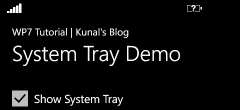In Windows Phone 7, the System Tray is the small bar across the top of the screen in Portrait mode. It displays the Signal strength, Current time and Wi-Fi connection strength.
In this post, we will learn more about Windows Phone 7 System Tray. It is easy to write code to show or hide the tray. We will use a small demo to demonstrate it.
System Tray
System Tray is the small tiny bar across the top of the Phone screen. It displays in Portrait mode. When your application is set in Portrait mode, the height of the System Tray becomes 32 pixel and when the application is set in Landscape mode, the width of the System Tray becomes 72 pixels. This is as per the UI Design Guidelines and Interaction Guideline of Windows Phone 7.
It is not a good way to hide the System Tray as it displays various important information to the user. But in some cases, you may want to hide the System Tray.
Demonstration of Show/Hide
To start with the code, let us design our page with a CheckBox inside it. This will fire the event to show or hide the System Tray. We will add a CheckBox in the page to show or hide the System Tray. Here is the XAML code for your reference:
<Grid x:Name="ContentPanel"
Grid.Row="1" Margin="12,0,12,0" VerticalAlignment="Top">
<CheckBox Content="Show System Tray"
Checked="ShowSystemTray" Unchecked="HideSystemTray"/>
</Grid>
Here is the code implementation:
private void ShowSystemTray(object sender, RoutedEventArgs e)
{
SystemTray.IsVisible = true;
}
private void HideSystemTray(object sender, RoutedEventArgs e)
{
SystemTray.IsVisible = false;
}
When the “Show System Tray” is checked, you will see the System Tray bar at the top of the screen as shown in the first figure below:


Uncheck the “Show System Tray”. This will hide the System Tray bar from the screen. Hope, this tip was helpful for you to understand it clearly.
